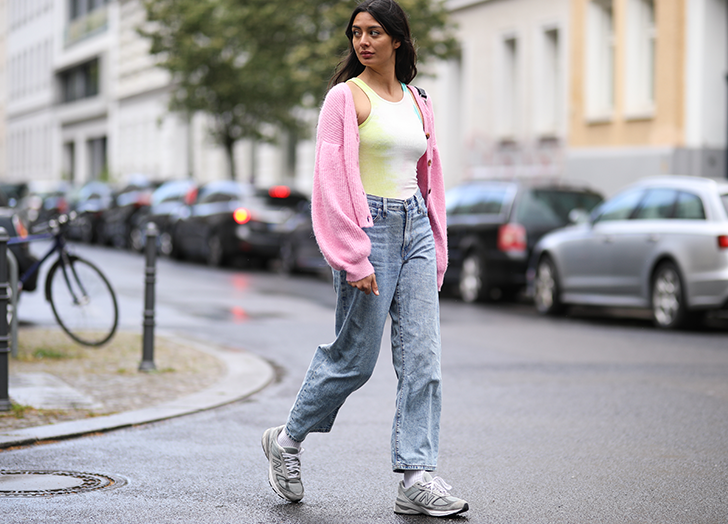How to Shrink Jeans So They Fit Like a Glove

The best thing about denim with spandex or elastic built in is all that stretch. The worst thing is the tendency it has to stay stretched, which results in baggy knees, saggy bums and ill-fitting waistlines. All denim is subject to wear and tear over time, which explains why your skinny jeans and boyfriend jeans tend to fit and feel different a few years after you bought them. So, is there way to successfully shrink denim back to its former glory? Short answer: yes…and no.
We talked to three denim experts about how to shrink jeans, how much shrinkage we can expect to see and when to admit defeat and simply buy another, better fitting pair of jeans.
RELATED: The 12 Best Jeans for Short Women, According to a Fashion Editor

How to Shrink Jeans
The absolute easiest way to shrink denim is by washing and drying it at high temperatures. Running your jeans through your washer and dryer set on high should be sufficient, but there are some additional concerns to consider.
“As a general rule, washing in warm to hot water and drying in a medium to high temperature cycle will just about do the trick, sometimes shrinking up to one size,” says Deborah Barton, designer at Jen7 for 7 For All Mankind. “Turning your garment inside out will help preserve the integrity of the wash a bit longer, but do keep in mind, the more you go through this process the more you’ll be breaking in your jeans.” Indeed, those same high temperatures that are helping to refit your jeans also wear down the fibers in the fabric over time, making this an OK method to employ every so often but not after every single wear. Repeat the process too much and you’ll find your jeans becoming progressively thinner, more prone to tearing and quite literally falling apart (and not in a cool vintage distressed sort of way).

How Much Will My Jeans Shrink?
Generally you can expect your pants or shorts to snap back to the way they fit when you first bought them (or at least close to it), but if you were hoping to shrink your jeans by a few sizes, then washing them is not the way to go.
The level of shrinkage depends largely on the type of denim you’re working with—super-stretchy, raw, vintage, etc.—as well as what sorts of treatments were applied to it during production. “Most denim mills making stretch denim fabric work really hard processing the fabric in an effort to remove as much shrinkage as possible. When the industrial wash is conducted, almost all of the shrinkage is removed so that when the customer washes the garments they do not shrink much,” says Lara Knight, vice president of design for American Eagle Outfitters bottoms.
The color of the dye or wash applied, alongside any distressing or bleaching, can also have an effect on your denim’s ability to be manipulated. Each of those processes work the fibers of the denim in different ways, either to make the fabric more rigid, softer, less or more prone to distressing or even stretchier. But as Knight notes, brands try their best to create a final product that won’t shrink or fade too much over time or with regular washing. So it’s unlikely your at-home washer and dryer will have a super-strong effect after all the industrial washing, dying and fabric treating.
RELATED: 6 Real Women on the Best Plus-Size Jeans They’ve Ever Worn

What If Washing and Drying Isn’t Working Out the Way I’d Hoped?
It’s time to bring in the pros, which in this case means taking your jeans to a tailor. “It will always be a gamble to shrink a pair of jeans to improve the fit,” says Scott Tucker of the Center of Excellence-Denim for Wrangler Design. “Simple adjustments like inseam length and adding darts at the waist can easily be done by a tailor and would be more exact.” And, according to Knight, if your denim still isn’t fitting the way you want after three to five rounds of the high temperature wash/dry method, you need to start looking at other options.
What If the Tailor Is Too Expensive?
You might find it more economical (or just easier) to buy a new pair of jeans. With the wide variety of sizes, fits, silhouettes and denim types out there, all three experts seemed confident that there truly is a perfect fitting pair out there for everyone. “Jeans are so personal. I would say, think about what is important to you when you are looking for a new pair. Find a brand that embodies what you value and shares your commitment to uphold them consistently,” advises Barton. So, what’s the quickest way to track down a brand that’s likely to fit your body type, style or budget? Good old-fashioned Googling. Do a search for “the best jeans for tall women” or “jeans for women with athletic thighs.” Read any and all on-site reviews, especially those written by women of a similar height or weight (many websites now include that information alongside reviews).
You can also look at the models used. Khloé Kardashian's brand Good American is geared toward women with curvier lower halves, like Kardashian herself, which is reflected in the choice of models, to give equally curvy women a better idea of how the jeans might actually fit their frames. Unfortunately, shopping for jeans inevitably involves a lot of trial and error, but asking around, doing some research and putting in a little extra time could leave you with jeans that require no fit fixes at all.

